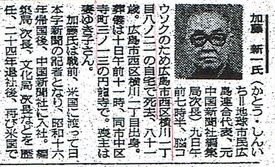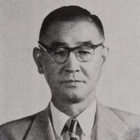According to the Chugoku Shimbun serial article "The Atomic Bomb and the Chugoku Shimbun" (March to May 2012), at the time the atomic bomb was dropped on Hiroshima, Kato Shinichi was the head of the news department for the Chugoku Shimbun. He walked around the city on the day of the bombing, and a month later he toured the ruins of the atomic bomb site as an interpreter and guide for Dr. Marcel Junod, the chief representative of the Red Cross in Japan who accompanied an American investigation team to Hiroshima.
What did he see there, and what did he think about it? Also, did it have any impact on his later life? Wanting to know more, I contacted Masami Nishimoto, an editorial committee member who signed the serial article, and asked him some questions.
Although I am a freelancer, Mr. Nishimoto and I are in the same business, and it would be a little presumptuous to ask for information just from him. However, Mr. Nishimoto's name seemed familiar to me. More than 40 years ago, I belonged to a writing and critiquing club at university. Our base of operations was a small, even dirtier club room in a dirty concrete building, which was shared with another club of film lovers, and as we inevitably ran into each other, the regular members naturally began to talk to each other.
There I met a man named Nishimoto Masami who had graduated the year before me. I had heard that he was originally from Hiroshima and had returned to his hometown to become a newspaper reporter, so I assumed he must be the editorial committee member in charge of this series and decided to get in touch.
Fortunately, a friend of mine from my school days, a journalist, had been in contact with Nishimoto as a journalist, and when I called him, he somehow remembered me. I explained the situation and asked him how I could learn more about Kato Shinichi. Later, he mailed me copies of articles about Kato and some of his own writings.
Obituary published in the Chugoku Shimbun
Among them was an obituary published in the Chugoku Shimbun on February 10, 1982. This finally revealed the entire story of his life up until 1961, which had been written in the "Centennial History." Although it was a single paragraph, the article summarized his life in 490 characters along with a small photograph of his face, as follows:
Shinichi Kato (representative of the Hiroshima Union of Global Citizens, former deputy chief editor of the Chugoku Shimbun newspaper) died at 7:30 a.m. on the 9th from brain cancer at his home in Yokokawa 1-8-21, Nishi-ku, Hiroshima. He was 81 years old. He was originally from Yokokawa 1-chome, Nishi-ku, Hiroshima. His funeral will be held at 11 a.m. on the 10th at Enryuji Temple, Teramachi 3-13, Naka-ku, Hiroshima. The chief mourner is his wife, Yukiko.
Before the war, Mr. Kato went to the United States and became a reporter for a Japanese newspaper. After returning to Japan in 1941, he joined the Chugoku Shimbun. He served as deputy chief of the editorial department and deputy chief of the cultural affairs department, and after leaving the company in 1949, he returned to work as a reporter in the United States, and spent about 40 years as a journalist in both Japan and the United States. During this time, he was exposed to the atomic bomb while working at the Chugoku Shimbun. After his younger sister and brother died in the atomic bombing, he joined the World Federation Construction Movement. In November 1952, he served as secretary-general when the World Federation Construction Alliance (headquartered in the Netherlands) held its Asian conference in Hiroshima. After that, he devoted himself to the peace movement as the representative of the Global Citizen Hiroshima Union in the "Global Citizen Movement" proposed by former UN Secretary-General U Thant.
In 1978, he participated in the "Great Mobilization for Survival" held by a civic group in New York in conjunction with the First Special Session of the United Nations General Assembly on Disarmament, carrying a portrait of his late brother and sister. He was also planning to go to New York as a member of a peace group for the Second Special Session of the United Nations General Assembly on Disarmament in June of this year.
He lost his sister and brother in the atomic bombing...
There is no mention in this book of his editing of "Hyakunen-shi." After the war, except for a period when he returned to America to work as a journalist, we can see that he was deeply involved in the peace movement. And it says that the catalyst for this was "the deaths of his sister and brother from radiation exposure." It was here that I first learned that Kato had lost his sister and brother in the atomic bombing. I don't know why, but there is no mention of this in his profile in "Hyakunen-shi," nor is it mentioned in the afterword or elsewhere.
Kato spent his impressionable youth in America and was influenced by a certain someone, but when the war started he was interned in a camp, and when he returned to Hiroshima he witnessed the devastation of the atomic bomb. I imagine he had mixed emotions, but he also lost his sister and brother in the atomic bombing.
However, or perhaps because of this, he has since devoted himself to the international peace movement known as the Global Citizen Movement. In the afterword to "The Centennial History," he also praises American democracy, saying, "I hope that readers will observe the greatness of American democracy, which flows consistently and grows with time."
"Humans are one family"
I wondered what he thought about America and the atomic bomb. Or whether he had any thoughts about Japan's war responsibility. I was able to glean the answers to those questions little by little from another article that Nishimoto sent me.
Four years before Kato's death, an article titled "Hitomi" in the Chugoku Shimbun dated May 26, 1978 featured Kato as "Chairman of the World Federation Hiroshima Prefectural Council, visiting the U.S. to promote global citizenship." The article included a large posed photo of Kato, wearing glasses and with a plump face that resembled Kyosen Ohashi.
In the article, Kato speaks to the reporter.
"No country can maintain peace on its own. The philosophy of peace in the 21st century is interdependence. All humanity is one family...", "The anti-nuclear movement is no good because it's always fighting. You need to grow up. We've had enough of appeals and resolutions. The UN Special General Assembly on Disarmament is just a gathering of leaders representing national interests. It's nothing more than the International Odawara Conference", "Let's have the UN create a people's conference. We need to abolish nations and make the world into one federation. We need to redirect military spending to developing solar energy and increasing food production..."
These are powerful and idealistic words. However, it seems that this was not the idea he had in mind from the beginning. The article explains:
"At the time (of the atomic bombing), I was a newspaper reporter. I was exposed to the bomb in Nishi-Hiroshima while on my way to work. I rushed around to cover the story, and when I finally found my sister, her body was covered in spots. She died saying, 'I avenge my brother,'" he said.
The reporter must have heard what the younger sister said from Kato. If we take her words literally, she is asking him to get revenge on America.
The article continues.
"My entrenched desire for revenge began to change in 1951, when I attended the First World Federalist Asian Conference held in Hiroshima."
From this passage, we can see that Kato had once harbored feelings of revenge against America because of the words left by his sister, but his feelings changed after he became involved in the peace movement. Kato told the reporter, "My enemy is nuclear war." Not America.
When one thinks of family members who lost their sisters and brothers to the atomic bomb and who left their last words saying, "I want to take revenge," it is natural that one would be filled with a desire for revenge. Kato was the same way at first. However, after attending the First World Federation of Asian Conference, that negative energy seems to have turned into tremendous energy and was directed towards the peace movement.
I would like to know what Kato's experience of the atomic bomb was like, which was the starting point of his peace movement, and what the World Federation and Global Citizen movements were like after he overcame that experience. However, I will leave that for a while. Now that the overall picture of Kato's life is more or less clear, I would like to trace his life back to the time when he immigrated to America from Hiroshima.
(Titles omitted)
© 2021 Ryusuke Kawai







